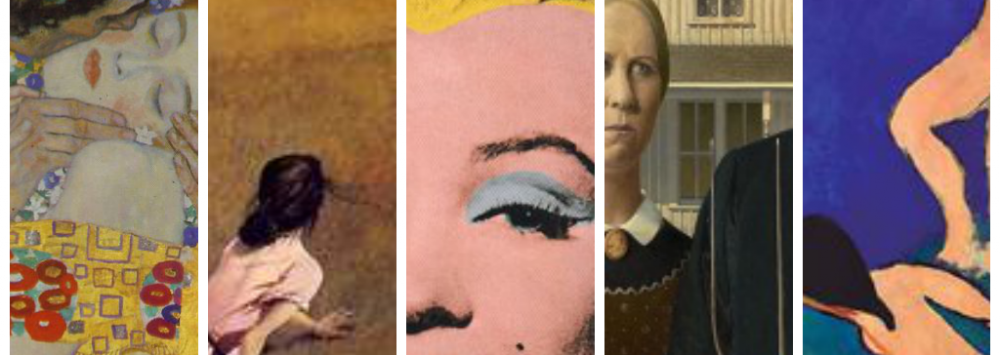Piet Mondrian
By Noah
Born in Amersfoort, Netherlands on March 7th, 1872, Piet Mondriaan was an important contributor to the De Stijl art movement. He was introduced to art at a very early age as his father and mother were qualified drawing teachers and his uncle was a pupil of Willem Maris of The Hague school– a group of artists prominent in the Netherlands between 1860 and 1890 and known for their realism. Mondrian began his professional career as a teacher in Primary Education, painting as a pastime.
In 1911, Piet left the Netherlands for Paris, dropping the second “a” in his last name to signify his departure from the Dutch culture. While Mondrian was visiting his hometown in 1914, the violence of World War I began, forcing him to remain there for the next four years. Upon the War’s conclusion in 1918, Mondrian returned to Paris where he would remain until 1938 and embrace the artistic style for which he is most well known. In September of 1938, he left France once again, only now for London in the face of fascism’s spread. Two years later, he left for Manhattan, where he would remain until his death.
The Movement
De Stijl was coined by Mondrian and his colleague, Theo van Doesburg, whom he met in 1914 during his stay in the Laren artists’ colony. While ‘De Stijl’ was already the name of the artistic group, Mondrian gave his journal this title, and it was in this that he published his essays defining the theory he would call Neoplasticism. Influenced by Cubist painting, De Stijl celebrated ultimate simplicity and abstraction, using only horizontal and vertical lines, rectangular shapes, primary colors– red, yellow, and blue– and primary values– black, grey, and white.
De Stijl’s stylistic influence spread beyond painting, reaching into the world of architecture and fashion. De Stijl influenced the style of Bauhaus, which was a huge step forward in the modernist movement for its representation of a post WWI Germany. Yves Saint Laurent, a world renowned French fashion designer, released a collection of dresses in 1965 dedicated to Piet Mondrian’s De Stijl style paintings, titling it ‘The Mondrian Collection’. De Stijl also had some influence in music, particularly on the work of composer Jakob van Domselear who’s composition Proeven van Stijlkunst, “Experiments in Artistic Style”, was inspired mainly by the work of Mondrian.
Mondrian’s Technique & Influences
Piet Mondrian never left his comfort zone of painting. He did, however, go through a number of techniques before settling into his famed niche of Neoplasticism. During his early artistic career, Mondrian worked primarily with landscapes, embodying the traits of an Impressionist. This was most likely the case because of his uncle’s stylistic influence as a student of the Dutch Impressionist Hague School and his time on the Dutch countryside. While Mondrian’s earlier, Impressionistic work and his later, Cubist and Neoplasticist work differ greatly in their degree of simplicity and style, their common thread is in their connection to Mondrian’s theosophical studies.
Theosophy is considered a part of the broader field of esotericism, which refers to hidden knowledge or wisdom that offers individuals enlightenment once attained. Launched in New York during the late 19th century by Helena Petrovna Blavatsky, the Theosophical Society was one of the first theosophical initiate societies to emerge. Mondrian joined the Dutch branch of this society in 1909. What drew him to theosophy was Blavatsky proposal that a more profound knowledge of nature could be gained than thought humanly possible through this practice. Most of Mondrian’s work for the entirety if his life was inspired by his search for this “more profound” knowledge.
Aside from his familial influences, two of Mondrian’s most prominent influences were the Cubists Pablo Picasso and Georges Braque, whose works he first came across while living in Paris during the First World War. What set Mondrian apart from the Cubists, however, was his lasting connection to theosophy.
21st Century Comparison
While not being driven by theosophy or some other form of esotericism, Shahzia Sikander is an artist who’s main influence is her religion. Born in 1969 in Lahore, Pakistan, Sikander attended the Rhode Island School of Design, received her MFA in 1995. Raised as a Muslim, Sikander explores the relationship between Islam and Hindu, while also challenging the view Westerners have of Muslim women as only victims of oppression. Sikander’s relationship with her work– that it is driven by her pursuit of deeper knowledge– parallels Mondrian’s relationship in this way. In terms of technique, Sikander’s and Mondrian’s styles could be seen as polar opposites. Sikander’s specialty is the production of miniature paintings, which require attention to even the most minute detail. Mondrian contrastingly celebrates simplicity through his De Stijl paintings.
My Thoughts
Though Piet Mondrian may not be one of the most well known artists of the 20th century, I feel as though, after studying him, he played a significant role in influencing a few styles that are more prominent today, take Bauhaus, for example. My favorite part of this WARP was learning about the story behind Mondrian’s shift from Impressionism to Neoplasticism, considering how abrupt it seems. When comparing his 1895 painting “Landscape with a Ditch” to his 1943 painting “Victory Boogie-Woogie”, I never would have guessed they were by the same man.
Gallery
Sources
Devi, Faisal, Ed. “Shahzia Sikander; Artist Statement, Lahore Literary Festival 2014.” Shahzia Sikander. Pakistan Newsweek, 4 Feb 2014. Web 3 Apr. 2014.
Guggenheim.com
Arthistoryunstuffed.com

 </a
</a


